Ultimate Guide to Caring for Your Pet Birds
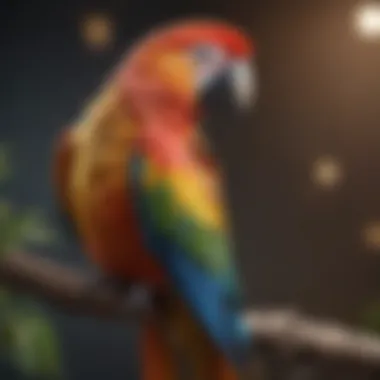
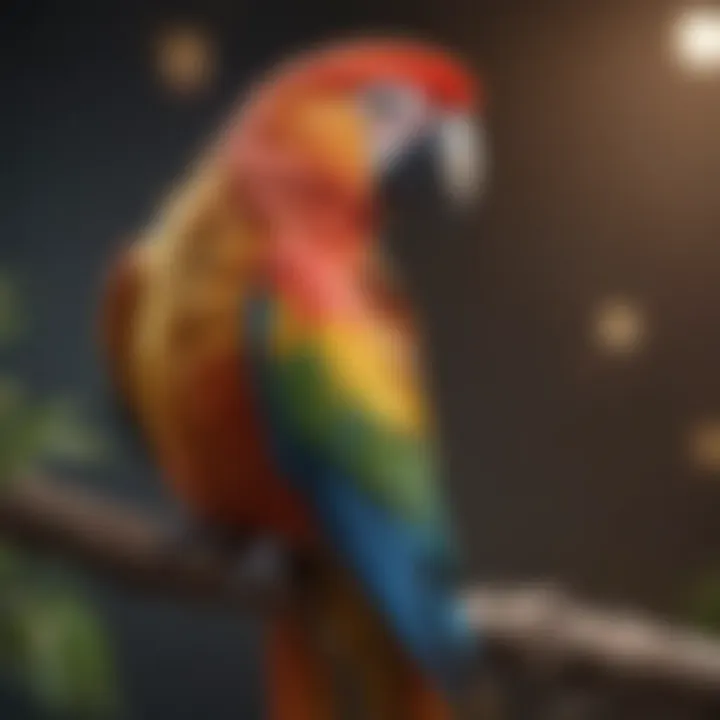
Intro
Caring for live pet birds encompasses various aspects, reflecting the complexity and reward of nurturing these beautiful creatures. Each bird species has its unique needs, requiring attention to detail in terms of diet, habitat, and social interaction. The bond between a bird and its caretaker can be deep, but only if one understands the subtleties of avian behavior and care standards.
A thorough understanding of their requirements leads to a fulfilling experience for both the owner and the bird. Therefore, this guide is valuable whether you are a seasoned aficionado or a novice looking to welcome a feathered friend into your life.
Care Tips
Taking care of pet birds involves several daily routines that ensure their comfort and health. Each routine can be simple but crucial in fostering a positive environment.
Daily Care Routines
Feeding and cleaning are among the most essential daily practices for bird owners.
- Provide fresh food and water every morning. This small habit sets the tone for the day and keeps birds healthy.
- Spend time with your bird. This interaction is vital for their social well-being.
- Monitor their behavior during feeding. Changes could indicate health issues.
Cage Setup and Maintenance
A birdcage should be spacious enough for flight and play while providing a safe environment.
- Avoid overcrowding. Place gardening toys or perch specifically designed for birds inside the cage, ensuring ease in movement.
- Regular cleaning of the cage is important. Dispose of contaminated materials and replace bedding consistently. This prevents病気.
Hygiene and Cleaning Practices
Ensuring a clean habitat is fundamental for avian health. Daily cleaning tasks include:
- Spot cleaning food and waste.
- Weekly full cage cleaning including dish and perch sanitization.
- Monthly deep cleaning of all accompaniments.
Seasonal Care Adjustments
Bird care should change with the seasons. In warmer months, ensure adequate hydration and cooler habitats. As temperatures drop, create warmer environments to maintain comfort.
Behavioral Insights
Understanding the way a bird communicates and behaves can improve your interaction with them. This is essential for building a loving relationship.
Understanding Bird Body Language
Birds express themselves significantly through their posture and movements. A bird seated upright with feathers slightly fluffed may be content. A crouching position might indicate fear or nervousness.
Common Behavioral Issues and Solutions
Behavioral problems can arise due to stress, changes in environment, or lack of stimulation. Observing your bird's reactions can inform targeted interventions:
- Instead of scolding, gently redirect their behavior with training.
- Provide stimulating exercises to maintain mental sharpness.
Positive Reinforcement Techniques
Reinforcement should always lean toward positive approaches. Reward good habits with treats or affection. This encourages desirable behavior and enhances trust.
Social Interaction Needs
Birds are inherently social creatures. Isolation can adversely affect their mental state. Consistent human engagement or pairing birds can fulfill their social requirements.
Nutrition Guides
Diet is pivotal in a bird's overall health yet can be confusing for new owners. Understanding necessary components helps formulate a balanced diet.
Essential Diet Components
A well-rounded diet includes seeds, pellets, and fresh fruits or vegetables. Familiarity with the dietary necessity of specific species is crucial for appropriate feeding.
Safe and Toxic Foods
Knowing safe and toxic foods can prevent harmful reactions:
- Safe: apples, carrots, leafy greens.
- Toxic: avocado, chocolate, onion.
Supplements and Treats
In some cases, incorporating vitamin supplements may be necessary, but seek guidance before introducing new products. Natural treats can be beneficial as training rewards or nutritional boosts.
Feeding Strategies for Different Species
Different species bring about varying requirements:
- Parakeets thrive on seeds and pellets.
- Larger species like cockatoos benefit more from fresh fruits.
Wellness and Health
Routine checks play a significant role in preserving avian life and optimizing wellbeing.
Routine Health Checkups
Similarly to how one monitors a child’s growth, bird owners must be vigilant about regular health evaluations. Just like any exeptional partner animal certainty on migration durations foresee cat’s measurable health.
Identifying Symptoms of Illness
Many vital signs help detect potential issues:
- Change in eating habits.
- Feather plucking or loss.
- Lethargy or abnormal vocalizations.
Preventative Care and Vaccinations
Preventative habits could lead to fewer vet visits. Some avian species benefit from specific vaccinations and management of environment-related stressors to minimize illness.
Mental and Emotional Well-being


Providing opportunities for mental exercise is just as crucial as physical health. Interactive toys, mirrors, or exploring diverse habitats enhance their emotional status.
Enriching Activities
Engaging birds in stimulating activities keeps them happy and fit.
Toys and Playtime Ideas
Different toys promote fresh behavior. Rotate playthings to expose birds to varied experiences. Cardboard tubes, ladders dissect, and ledges meet creative requirements.
Training and Tricks
Basic commands can carve out a bonding experience between bird and owner. Teach tricks using verbal cuesor treats.get creative! An trick-admissions schedule brings not just fun but measure constructive dialogues.
Outdoor Activities and Interaction
If possible, regular outdoor experiences promote mental and physical health will also prove safe with supervised activities will yield significant felest behaviour enfact.
DIY Projects for Mental Stimulation
Engage your bird with simple DIY toys, like paper maché or even voila shapes with common cardboard. These can bem bruce manageable manners increasing their mental capacities.
By grasping the principles in this guide, new owners can create a healthy and nurturing home for their pet birds. Knowledge about birds can spur better relationships, meaningatrix wear out stages.
Seeking knowledge leads to enhancing the experience with pet birds, forming lasting bonds of care and companionship.
Prolusion to Live Pet Birds
Caring for live pet birds is a rewarding experience that can significantly enrich your life. Birds have unique personalities and social needs, and understanding these is crucial for their well-being. From enthusiastic parakeets to aloof finches, each species possesses distinct traits that influence how they should be handled and cared for.
One important consideration when owning a bird is the nature of their care requirements. Unlike traditional pets such as cats or dogs, birds often demand specialized attention in terms of habitat, diet, and social interaction. Improper care can lead to health issues, such as obesity or stress, which can easily diminish their quality of life.
Moreover, providing adequate stimulation is vital as it keeps your bird active and engaged. Birds thrive in dynamic environments, where they can explore, forage, and exhibit natural behaviors. Working on improving your understanding of their physical and mental needs builds a deeper bond with them and fosters trust.
Bird care also necessitates a degree of knowledge regarding signs of distress or illness. Recognizing when your feathered companion is unhappy or unwell requires observation and a willingness to learn about avian health practices. Every owner should educate themselves on what to look for, including changes in behavior or plumage, which often signal underlying issues.
The wellbeing of pet birds relies heavily on proper habitat setup, nutritional balance, and socialization. Essentially, a harmonious relationship is established through the owner's efforts and commitment.
Thus, understanding the complexities of live pet birds is essential. It allows owners to make informed decisions and provide a nurturing environment conducive to their overall health. Owning a bird is not just a simple choice; it is a long-term commitment that weaves into the fabric of daily life. Each step taken towards better understanding and care greatly impacts their happiness and longevity.
Understanding Bird Species
Understanding bird species is essential for anyone considering a pet bird. This knowledge affects many aspects of bird care, from habitat design to dietary requirements and even socialization. Different species come with varying needs, temperaments, and characteristics. Misunderstanding these aspects can lead to an unsuitable environment, which ultimately harm the bird's well-being.
Bird species differ by size, life span, dietary needs, social behaviors, and vocalization. Recognizing these traits helps potential owners make informed decisions in selecting and caring for their future companion. More importantly, understanding species can aid in fruitful bond formation and drastically impact a bird's happiness in captivity.
Popular Pet Bird Species
Numerous species can be found in homes around the world, each with its own unique behaviors and care requirements. Among the popular pet bird species are:
- Budgerigar: Also known as budgies, these small parakeets are friendly and relatively easy to train. They have vibrant colors and a playful nature.
- Cockatiel: With a crest that can be raised or lowered, cockatiels are known for their charming personalities and their ability to mimic sounds.
- Lovebirds: These compact parrots are known for their strong pair bonds. They are playful and require social interaction to avoid loneliness.
- African Grey Parrot: Renowned for their intelligence and impressive vocal abilities, these birds thrive on mental stimulation. They are often recommended for experienced bird owners.
- Canary: Available in numerous color variations, canaries are known for their melodious singing. They prefer to live alone but can benefit from interaction with their owners.
The selection of a bird species plays a crucial role in the bird owner's experience and overall satisfaction.
Choosing the Right Species for Your Lifestyle
Selecting the appropriate bird species should align with individual lifestyle factors as well. Consideration must be given to factors such as:
- Time Commitment: Some birds require more attention than others. Finding a species that fits your availability for handling and interaction is vital.
- Space Requirements: Larger species like macaws necessitate spacious habitats, while smaller birds can thrive in more compact spaces.
- Activity Level: Active birds need larger cages and enriching environments to prevent boredom, while others are more sedentary and require less room to play.
- Allergies: Consider if anyone in the household has allergies. Some species produce more dander than others, leading to potential health issues.
Each factor plays a critical role in your selection process and eventually affects the bird’s happiness. A responsible choice will foster a lasting relationship for both the bird and its human owner.
Creating a Suitable Habitat
Creating a suitable habitat for pet birds is fundamental to their well-being. The environment in which your bird lives affects not only its health but also its behavior and overall happiness. A proper habitat goes beyond just a cage; it encompasses all the elements that contribute to a bird's natural instincts and comfort.
A suitable habitat must address several key aspects. First, it must provide enough space for the bird to move freely. Birds are active creatures and need adequate area to hop, fly, and exercise their wings. Beyond space, the habitat should mimic a natural environment. This can include appropriate lighting, temperature levels, and humidity which can significantly affect your bird's health.
Moreover, it is vital to consider the layout and positioning of the cage. It should be placed in a draft-free area where the bird can feel secure yet part of family life. Importantly, where you set up the cage directly impacts the bird's engagement and social interaction with both humans and other pets.
A well-designed habitat can lead to reduced stress among birds, promoting improved health and longevity.
Cage Requirements and Design
The cage is the core component of a bird's habitat. Choosing or designing an appropriate cage involves several critical criteria. The size of the cage will vary depending on the species. For instance, larger birds like macaws require significantly larger enclosures than parakeets.
Besides size, bird cages must also allow for good air circulation and visibility. Bar spacing is another factor to consider. For small birds, the spacing should be small enough to prevent escapes, yet provide suitable grip for climbing. For larger birds, the bars need to be strong yet positioned adequately for stimulation.
- Consider varied cage shapes such as rectangular or rounded which can help fulfill jumping and flying needs.
- Ensure that the construction is safe, with non-toxic materials free from harmful paint and finishes.
- Plan for additional space for perches, feeding bowls, and toys, which all should encourage natural behaviors like climbing and exploring.
Essential Accessories and Toys
Accessories and toys play a pivotal role in creating a stimulating environment for pet birds. Birds are intelligent and playful animals requiring mental and physical engagement. Failure to provide stimulating activities can lead to boredom and related behavioral issues.
Essential accessories include:
- Perches of different diameters to promote foot health and exercise. Their placement is crucial to facilitate movement and accessibility to food and water.
- Food and water dishes that are easy to clean and refill, ideally attached but removable to ensure security. Use stainless steel for hygiene and durability.
- Cages liners or substrates to maintain cleanliness and easier waste management. Use options that are absorbent and safe for birds.
In terms of toys, options should vary widely, including:
- Chewing toys made from wood or paper that help maintain beak health.
- Ladders and swings promoting physical activity and exploration.
- Interactive and foraging toys can provide intellectual challenges, mimicking the natural foraging behavior. Birds enjoy anticipation and engagement during playtime.
By ensuring all these elements are considered, setting up a suitable habitat that fully caters to the physiological and psychological needs of pet birds can generate a more enriching living space.
Nutrition for Pet Birds
Nutrition is key for pet birds as it greatly influences their overall health and seeks to prevent potential health issues. A well-balanced diet ensures vibrant feathers, strong bones, proper digestion and boosts the immune system. Undoubtedly, selecting the right food simplifies the process of keeping your bird companion healthy. Each species has unique dietary needs, so understanding these requirements is crucial for pet owners.
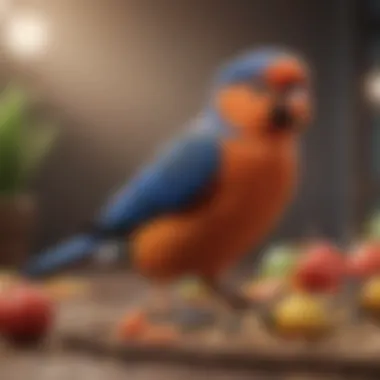
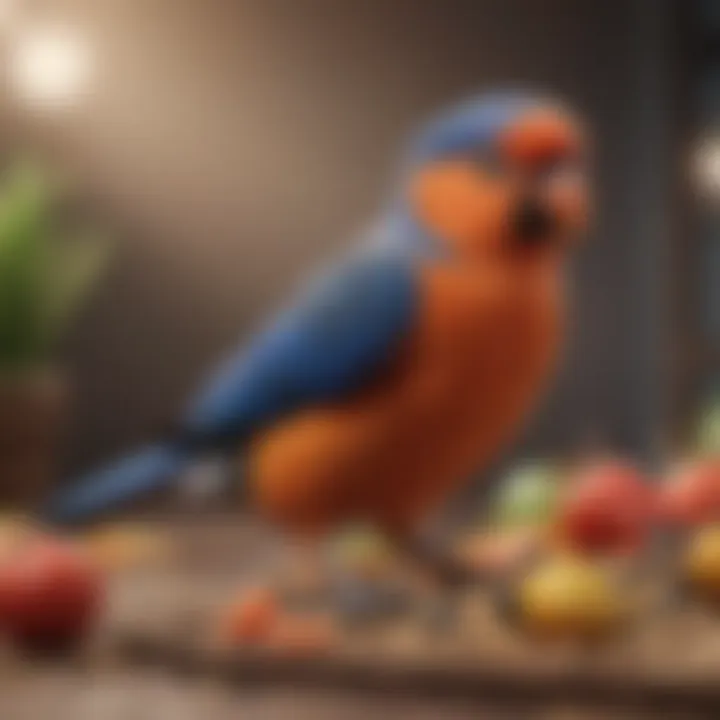
Understanding Dietary Needs
Birds have specific nutritional needs that differ from mammals and other pets. A high-quality diet typically includes a mixture of fresh fruits, vegetables, seeds, nuts, and specially-formulated pellet mixes. For instance, some species may require higher protein intake, while others need more carbohydrates or fibers.
Key dietary components:
- Proteins: Important for growth and repair.
- Fats: Needed for energy but should be given in moderation, especially in the form of seeds.
- Carbohydrates: Provide energy sources, especially through grains.
- Vitamins and minerals: Essential for preventing deficiencies and ensuring long-term health.
Birds may exhibit signs of poor nutrition, such as lethargy, feather damage, or changes in droppings. Thus, always observe your bird’s behavior and appearance.
Different Types of Bird Food
Understanding the various types of food options can help create a well-rounded diet for your pet bird.
- Pellet-based diets: These formulated nuggets contain a blend of necessary nutrients specifically designed to meet a bird's dietary needs. Common brands include Lafeber and Harrison’s.
- Seeds and grains: Though seeds are often favored, a diet solely based on them can lead to health issues due to a lack of variety. Mix in different grains to create more balance.
- Fruits and vegetables: Fresh produce adds necessary vitamins and moisture. Suitable options include carrots, spinach, and apples.
- Special treats: While treats can be rewarding, keep them in moderation to ensure they don’t upset the day-to-day dietary balance.
A variety of foods keeps your bird interested and healthy.
Supplements and Treats
Even with a balanced meal plan, supplements may provide an added boost. Some bird owners opt for supplemental vitamins or minerals during seasonal changes or to revive a bird’s energy.
Types of Supplements:
- Multivitamins: Additional support to cover any missing nutrients.
- Calcium sources: Critical for many birds, particularly breeding females, to form eggs.
- probiotics: Helps in maintaining gut health, especially after antibiotic treatment.
Choosing Treats Wisely:
A limited amount of nuts or dried fruit can serve as effective rewards during training sessions. Just be mindful not to stress their primary diet.
Creating a personalized and nutritious meal plan is one of the best things you can do for your pet bird’s health and happiness. Regular evaluation of their dietary habits leads to a happier and healthier avian companion.
Behavioral Insights
Behavioral insights are essential for any responsible pet bird owner. Understanding these insights helps ensure that both the birds and their owners can coexist in harmony. Birds exhibit a range of behaviors that reflect their emotional states, social inclinations, and environmental interactions. Recognizing these behaviors can significantly improve avian care and lead to a healthier companionship.
Common Bird Behaviors
Birds are naturally social creatures. Their behaviors often revolve around social interaction, territory, and communication. Here are a few key behaviors to observe:
- Vocalization: Birds often chirp, squawk, or mimic sounds. This is a means of communication. Listening to your bird’s vocalizations helps in understanding its mood and desires.
- Preening: Birds spend significant time grooming themselves. This behavior not only keeps their feathers clean but also helps to strengthen social bonds with their human companions. A bird that is preening can indicate it feels safe and content in its environment.
- Exploration: Many birds enjoy exploring their surroundings. This could mean climbing, playing with toys, or even attempting to interact with household items. Providing a safe environment for exploration stimulates their intellect.
- Feeding Rituals: Birds often display specific behaviors during feeding times. Watching how your bird behaves around food can offer insights into its health and preferences.
Understanding Body Language
Birds communicate through a complex system of body language. Subtle indicators can reveal a lot about how a bird feels. Understanding these signals is important and helps prevent misunderstandings that can lead to stress or behavioral issues. Here is what to look for:
- Feather Positioning: A bird’s feathers can express various emotions. For instance, feathers that are puffed up can mean the bird is feeling cold or is scared. Conversely, sleek feathers often show confidence.
- Tail Movements: Rapid tail bobbing indicates excitement, while a lowered tail may point to fear or submission.
- Eye Pinning: Some birds exhibit a pinning motion of their pupils when excited or irritated. This shift can mean that their emotional state is changing rapidly, indicating a potential need for further observation.
- Body Posture: If a bird is standing tall with its chest out, it likely feels dominant or confident. However, shrinkage or hunching can suggest anxiety or submissiveness.
Understanding these behavioral insights significantly contributes to better bird care. When owners recognize both general behaviors and specific body movements, they can respond more effectively to their pet birds’ needs.
Ultimately, spending time observing these behaviors leads to a stronger bond between pet birds and their owners. Observation along with interaction informs owners about their bird's needs and preferences.
Social Interaction and Bonding
Social interaction and bonding are core elements in the overall well-being of live pet birds. Birds are naturally social creatures. In the wild, they form complex social structures and rely on their companions for communication and companionship. A pet bird's health, both physically and mentally, can atmosphere by a lack of interaction. Owners need to prioritize this aspect considerably. This section will explore the significance of social interaction as well as the ways to strengthen bonds with your avian friends.
The Importance of Social Interaction
Social interaction is crucial for pet birds. It plays a significant role in their emotional and psychological health. Birds may suffer from stress, anxiety, or even severe health issues due to solitude. Regular social engagement ensures they experience healthier emotional states. This is essential for well-adjusted behavior in birds, which can lead to a considerable improvement in quality of life.
Here are some key benefits of social interaction:
- Emotional Stability: Engaging your pet bird frequently aids in avoiding feelings of loneliness.
- Reduced Behavioral Problems: Many behavioral issues stem from inadequate socialization. More interaction may reduce biting, screaming, or feather-plucking.
- Physical Activity: Interactions can encourage movement, flight, and play, contributing to better physical health.
Birds thrive in environments that provide both social stimulation and affection.
Establishing routines that include interactions fosters a sense of security for your bird, allowing them to learn and become more confident in their environment.
Building a Strong Relationship
Building a strong relationship with your pet bird demands patience and time. A genuine bond will enrich both your lives, creating a nurturing environment for the bird. Start from the moment you bring your pet home. Give them adequate time to acclimate to their new surroundings. Then, introduce small actions to build that connection.
The following suggestions can help foster a good relationship:
- Consistent Communication: Regularly talking or singing to your bird helps cultivate familiarity.
- Daily Interaction: Set aside time each day for play, training, or simply being close to your bird.
- Touch and Handling: If your bird is comfortable, gentle touch during handling can enhance trust. Start slowly and allow the bird to conditionally choose contact.
It is vital to respect your bird's boundaries during this process. Each species responds differently, so tuning in to their individual comfort levels will help guide your interactions. The goal is to create a robust mutual understanding, extending security and trust between you and your pet bird.
Health and Wellness
Caring for pet birds goes beyond mere companionship; it importantly includes ensuring their health and well-being. Health and wellness are the foundations for prolonged happiness, longevity, and good quality of life for these creatures. A holistic approach combines nutrition, regular check-ups, and understanding their unique medical needs. Owners who commit to proactive health management create an enriched environment where birds can thrive physically and mentally.
Common Health Issues in Birds
Birds are susceptible to several health issues that can develop if not addressed urgently. It is crucial to be proactive in identifying those conditions. Here are the most common problems:
- Feather plucking: This often stems from boredom, stress, or medical conditions.
- Obesity: Wrong nutritional choices can lead to weight gain that adversely affects mobility and general health.
- Respiratory issues: Dust, smoke, or mold can harm birds' fragile respiratory systems.
- Psittacosis: Being a bacterial disease associated typically with parrots, it can affect both the bird and humans.
- Avian Gastric Yeast: This condition occurs more often in social birds and requires immediate intervention.
Detecting these conditions as early as possible is vital. Bird owners should educate themselves about subtler signs such as changes in temperament, decline in activity levels, or abnormal droppings.
Regular Check-ups and Veterinary Care
Frequent veterinary visits play a central role in maintaining avian health. Routine check-ups allow for early detection of ailments and help ensure preventive care. It is advisable to establish a regular vet schedule:
- Annual well-checks: These check-ups often include physical examinations, beak and feather analysis, and tests for parasites or other hidden health problems.
- Vaccinations: Consultation about necessary vacunas, such as for psittacosis, is crucial to apply preventive strategies.
- Health history: Keep detailed medical records for your bird; this can greatly aid any veterinary assessments.
Regular veterinary care is essential for maintaining the health of your pet birds, effectively preventing illnesses, and ensuring they live longer vier health lives.

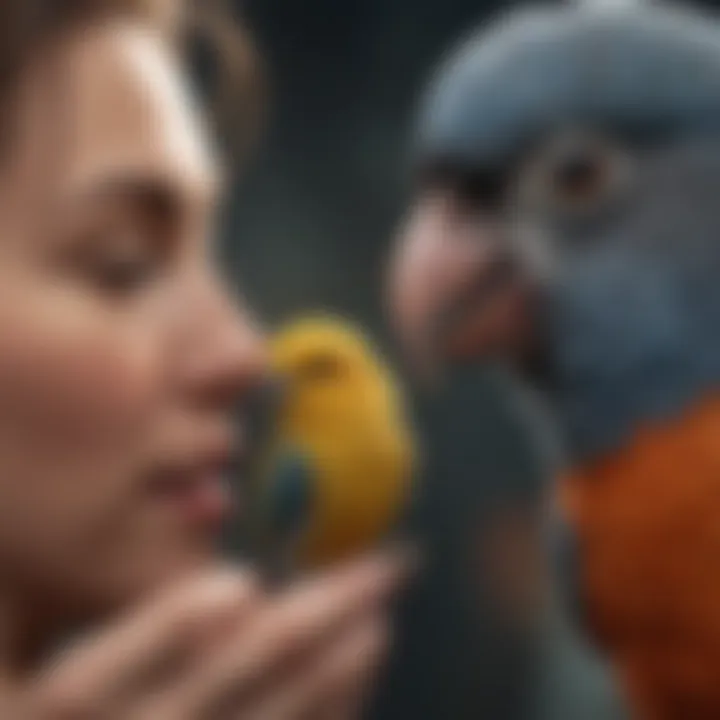
Bird owners should find a vet specializing in avian care. Resources like Avian Medicine Websites can help in identifying qualified professionals. Prioritizing regular health check-ups makes a great impact on your pet's life.
Maintaining health and wellness ensures birds are not just present physically but also busy, social, and happy. An informed and engaged bird owner is key in assuring a fulfilling avian life.
Enrichment Activities for Birds
Enrichment activities are essential for the overall well-being of pet birds. These activities stimulate the mind and may encourage natural behaviors, reducing boredom and distress. An engaged bird is a happy bird, and providing varied forms of enrichment is a key factor in their daily life. Social interaction, physical exercise, and environmental stimulation can help birds lead healthier lives while strengthening the bond between the bird and owner.
Birds, like other pets, require mental and physical stimulation. Without it, they may develop destructive behaviors or health issues. Thoughtful enrichment activities will provide a more quality experience for both pet and owner. This section will delve into types of enrichment and strategies for interactive play and training.
Types of Enrichment
Several types of enrichment can benefit pet birds. Each of these types focuses on different aspects of a bird's natural behavior. Some types include:
- Environmental Enrichment: Modifying the cage and surrounding area. Add branches, plants, or other items to mimic natural habitat.
- Feeding Enrichment: Make the act of feeding more engaging by utilizing treat puzzles or hiding food throughout the cage. This brings both a challenge and a reward aspect to feeding.
- Social Enrichment: Encourage interactions with humans or with other birds. Social dynamics alter communication styles and behavior development.
- Sensory Enrichment: Introduce new colors and sounds into the environment. Rotate toys and sounds to capture curiosity.
Implementing a mix of these types prevents monotony and fosters natural instincts. However, moderation is key to avoiding overstimulation, leaving room for rest and social bonding.
Interactive Play and Training
Engaging your bird in interactive play and training not only stimulates them but also enhances the relationship you share. Learning sessions and games can build trust and communication between the owner and the bird. Useful strategies include:
- Simple Commands: Teach your bird basic commands, like
Environmental Considerations
The environment in which pet birds live plays a critical role in their health and overall well-being. These creatures are sensitive to the dynamics of their surroundings, and managing these factors can prevent stress, behavioral issues, and health problems. Therefore, recognizing and adapting environmental considerations are essential for any bird owner.
Safe Living Spaces
Creating a secure and comfortable habitat cannot be overstated. First and foremost, the design of the cage must ensure plenty of room for movement, perching, and rest. Birds should ideally not be confined to a space that feels cramped, as it affects their physical health and emotional state. Cage bars should be spaced appropriately to prevent escapes or injuries, and the materials should be non-toxic and safe.
Apart from the cage, ensuring your bird has a dedicated area for exercise and play can greatly enhance its quality of life. Make use of bird-friendly furniture or diverses perches in safe locations. Transitioning between different environments, such as going between indoor spaces, offers birds beneficial variety.
Additionally, implementing a structured cleaning routine is vital in maintaining a safe living area. Regularly removing waste, uneaten food, and debris keeps the habitat hygienic. Avoiding chemicals like strong cleaning products can safeguard against toxic exposure.
Birds thrive in an environment that is both safe and stimulating.
Managing Noise and Stress
Noise is often an unrecognized contributor to a bird's stress levels. They are naturally loud animals and their vocalizations can vary significantly depending on the species. However, extra environmental noise from household devices, telephones, and loud conversations can create discomfort in birds. Setting limits on loud disturbances is crucial; when possible, creating a quieter space for interaction is beneficial.
Moreover, the cage's placement within your home demands attention. Birds need to feel included in family activities, yet, too much direct chaos can induce fear or panic. Place the cage in a bustling yet directed area that allows for interaction without overwhelming noise.
Adjusting the lighting in the room can also alleviate stress. Birds possess a natural circadian rhythm, necessitating consistent day-and-night cycles. If artificial lighting is used, choose low-intensity lights during evening hours.
Following these guidelines not only comforts your pet bird but epitomizes a caring approach to ensure its happiness and health.
Traveling with Pet Birds
Traveling with your pet birds can be necessary for several reasons, from moving to a new home, going on vacation, or visiting a veterinarian. Regardless of the occasion, ensuring your birds' safety and comfort should be a top priority. Investing time into imaginative thought-out travel experiences can deliver significant advantages: building greater trust bonds, ensuring continued health, and sustaining comfort during travel.
Preparing for Travel
Preparation is essential when it comes to traveling with your birds. Careful planning can help avoid unforeseen circumstances. First, evaluate the duration of the journey. Longer journeys pose greater stress and require advanced planning.
- Choose the right carrier: The carrier should ideally provide adequate space for movement and play, and be well-ventilated. Options like plastic aviation carriers come highly recommended, as the materials and structure keep your birds both secure and contained.
- Behavior assessment: Consider your bird’s temperament. Birds that are comfortable around humans normally fare better during transit. For more skittish birds, consider gradual acclimation to the carrier before the travel day. Let them explore without presence of stress.
- Provide food & water: Ensure that your birds have access to food and water if the trip is extensive. Use food bowls that securely fit inside the carrier, and always carry a portable water bottle or bowl. Familiar food is also suggested to minimize stomach upsets.
- Comfort items: Adding familiar toys or perches can create a more reassuring environment inside the carrier. This familiarity fosters feelings of security.
Checklist before embarking:
- Carrier selected and checked for safety.
- Emergency care contact number accessible.
- Required supplies packed (food, water, any medications).
Safety Tips During Transit
Safety is crucial for the comfort and well-being of your birds during transit. Adhering to these pointers not only minimizes stressors but also ensures their health.
- No open windows: During travel, the windows in the vehicle must remain closed. Birds are delicate and can easily be injured if there is wind or sudden movement.
- Never leave unattended: Do not leave pets alone in a vehicle. If you must stop, take your birds with you whenever possible. If temperatures rise or drop, the interior may become hazardous very quickly.
- Monitor surroundings: Pay attention to the vibrations and sounds; sudden loud noises might frighten her. Place the carrier in a stable, non-vibrating installment like anchor it with seat belts.
- Control temperature: Ensure the temperature inside the vehicle remains comfortable. Proper air flow in the transportation compartment is vital.
As pet owners, you must consider your bird's comfort and safety equivalently during all modes of transit.
Successful traveling experience hinges upon your preparation and safety consideration. Also, maintaining a low-stress environment via gradual acclimatization may lead to a more pleasant journey by trust-building your pet.
Common Myths about Pet Birds
Caring for pet birds encompasses a vast range of responsibilities that require informed decisions and an understanding of their unique needs. To ensure the well-being of these creatures, it is vital to debunk common myths surrounding them. These misconceptions can lead to inadequate care, potentially harming birds physically and emotionally. A thorough exploration of these myths provides valuable insights for current and potential bird owners.
Debunking Misconceptions
Numerous misunderstandings exist about pet birds that can significantly influence how they are treated. Addressing these misconceptions is essential for fostering a proper environment for avian companions. Among the foremost myths are:
- Birds don't need veterinary care. It's a common belief that birds are low-maintenance pets. In actuality, birds require regular check-ups just like any other pet. They are susceptible to various health issues that may not be immediately visible. Without veterinary attention, illnesses can escalate, risking the bird's health and lifespan.
- Birds can live happily in a small cage. Some individuals think a small cage suffices since birds can fly within a confined space. Nevertheless, birds have a natural instinct to explore and find enrichmnet. A spacious cage, complemented by play areas, enrichs their lives and promotes mental stimulation.
- Only expensive foods are good for birds. While the quality of bird food does matter, it's vital to recognize that high cost does not always reflect better nutrition. Pet birds can thrive on a balanced diet that includes various seeds, pellets, fruits, and vegetables without breaking the bank. Quality over price should be the guiding principle when selecting food.
- Birds don't bond with their owners. Many assume birds cannot form attachments as some other pets do. In reality, many bird species are highly social. They can develop strong emotional bonds with their caregivers. Routine interaction strengthens this connection, providing both physical and emotional support.
- Birds are quiet pets. This belief can lead to disappointment. While some birds are quieter than others, many are naturally vocal. They chirp, squawk, or talk, creating an engaging atmosphere. Understanding the potential noise levels before choosing to bring a bird home is essential for a harmonious environment.
It is critical to challenge these myths as they form perceptions that influence the way pet birds are treated. Increased awareness can lead to better care practices, fostering healthier and happier birds.
“An informed owner is crucial for the welfare of pet birds. Understanding reality, as opposed to myths, transforms care into a more enriching experience.”
By integrating knowledge and reevaluating common beliefs, aspiring bird owners can foster a nurturing atmosphere that supports their cherished avian pets.
End
In this comprehensive guide, we have delved into various aspects crucial for the care of live pet birds. These fascinating creatures require thoughtful attention and a keen understanding of their needs to thrive. The conclusion serves as a vital reflection on the key points covered while underscoring their significance.
Ensuring Proper Care
Caring for pet birds entails considering their specific needs regarding habitat, nutrition, and health. A suitable environment with the right cage size and essential accessories promotes their physical and psychological well-being. Invest in quality materials and interactive toys to keep them engaged.
Focus on Health and Nutrition
Feeding birds a diverse diet is not just an extra task; it is essential. Birds thrive on a balanced meal that includes seeds, pellets, fruits, and vegetables. Additionally, being informed about common health issues helps in preventing problems and acting swiftly during sickness.
Social Interactions
Birds are inherently social beings. Thus, establishing strong bonds through regular interaction leads to happier birds, which contributes significantly to their quality of life. Activities such as interactive play and proper training solidify these relationships while meeting their instinctual needs.
Emphasis on Enrichment
Mental and physical stimulation through various enrichment activities is crucial for the satisfaction and well-being of pet birds. By offering a captivating environment, you will lessen the chance of boredom and related behavioral issues, manifesting your commitment to responsible pet ownership.
The care of pet birds is not merely about keeping them alive. It’s about fostering an enriching, supportive, and loving environment that promotes their happiness and overall wellness.
Overall, the importance of ending this guide reiterates the need for meticulous attention to detail. Embracing the responsibility of caring for a pet bird is not a fleeting obligation but a lifelong commitment that provides rewards of love, loyalty, and companionship.
For anyone looking to deepen their understanding further and stay updated on avian care, resources like Wikipedia, Britannica, Reddit, and various Facebook groups dedicated to bird owners can be invaluable.















